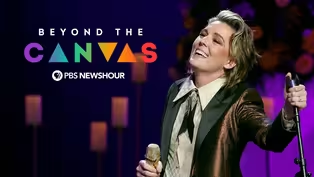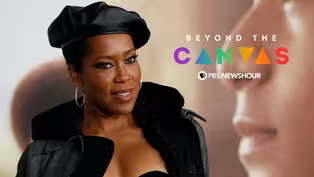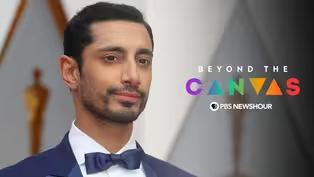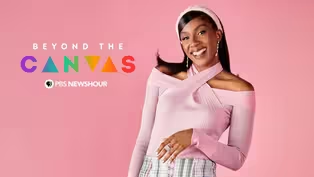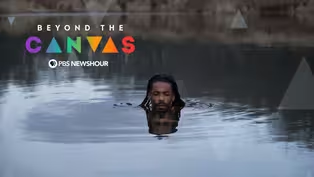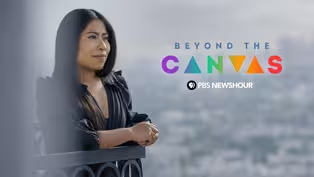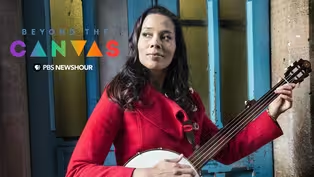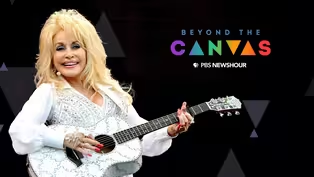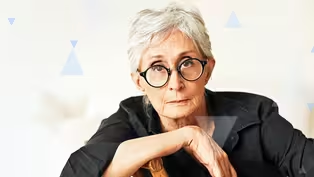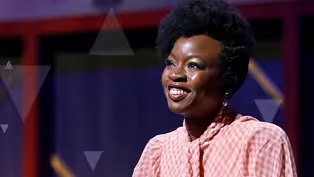
Beyond The Canvas: Episode 4
Special | 26m 4sVideo has Closed Captions
Making Movie Magic
On the Oscar Awards edition of Beyond the CANVAS, we sit down with winners and nominees to talk about their craft and commitment to storytelling. What does it take to execute a unique artistic vision? Creators behind films like Black Panther and Free Solo share secrets to their success, and we also hear from comedy duo Steve Martin and Martin Short.
Problems playing video? | Closed Captioning Feedback
Problems playing video? | Closed Captioning Feedback
Major corporate funding for the PBS News Hour is provided by BDO, BNSF, Consumer Cellular, American Cruise Lines, and Raymond James. Funding for the PBS NewsHour Weekend is provided by...

Beyond The Canvas: Episode 4
Special | 26m 4sVideo has Closed Captions
On the Oscar Awards edition of Beyond the CANVAS, we sit down with winners and nominees to talk about their craft and commitment to storytelling. What does it take to execute a unique artistic vision? Creators behind films like Black Panther and Free Solo share secrets to their success, and we also hear from comedy duo Steve Martin and Martin Short.
Problems playing video? | Closed Captioning Feedback
How to Watch PBS News Hour
PBS News Hour is available to stream on pbs.org and the free PBS App, available on iPhone, Apple TV, Android TV, Android smartphones, Amazon Fire TV, Amazon Fire Tablet, Roku, Samsung Smart TV, and Vizio.
Providing Support for PBS.org
Learn Moreabout PBS online sponsorshipMore from This Collection
A new half-hour program showcases some of the nation’s leading cultural creators -- musicians, playwrights, comedians, costume designers, among many others -- who show us how they turn their visions of the world into art.
Providing Support for PBS.org
Learn Moreabout PBS online sponsorship- [Voice Over] This program was made possible by contributions to your PBS station from viewers like you, thank you.
- This is now a standard on all the interviews the moving sideways camera.
- Yeah.
- But I always find it odd to cut to someone who's not talking, who'd be talking into camera.
- But you know, you've always struggled.
Remember when you struggled with the talkies, when the talkies given you were always, - I had to work on my voice (mumbles).
- Then don't keep looking at him remember we're being taped.
- Argh, just relax.
- Okay.
(bright upbeat music) - Hi everyone, this is Beyond The Canvas.
From PBS News Hour, I'm Amna Nawaz.
In this episode, we'll meet masters of the art of movie-making, Oscar winners and nominees.
You'll hear from comedy icon, Steve Martin and Martin Short, costume designer, Ruth Carter, documentarians, Jimmy Chin and Chai Vasarhelyi and legendary actress, Rita Moreno.
On this episode, you'll meet the people in front of the camera and behind it.
Comedian Steve Martin knows all too well the highs and lows of the Oscars.
He's hosted three times and picked up an honorary award in 2013.
His enduring legacy in Hollywood is matched by his lifelong friendship with fellow comedian Martin Short.
They recently teamed up for a Netflix special called, Now You See Them, Soon You Won't.
My colleague, Steve Goldbloom sat down with them for this special edition of brief, but spectacular.
- It's hard to make a career in show business, possibly even harder to sustain a career in show business.
Did you ever think that you would be relevant for this long?
- I guess he's talking to me.
(Laughing) - Lemme just say Steve, what an honor it is, for me to be standing next to a man who is a novelist, a playwright, a musician, a composer, and a legendary comedian.
- And let me say, what an honor it is for me to be standing next to the man who is standing next to that man.
(audience laughing) - Seeing you work together, it feels like it commands the attention the same way like an Oscar's monologue commands attention.
And then you slow things down and you become reflective and you're talking about each other's work.
Tell me about the design of your special in your tour.
- This was a real moment for both of us, when we were totally rehearsed, we'd done the show a hundred times, everything was just in its beautiful little comedic place.
- You know, it was a work in progress as we developed it... - And still is.
- I mean, there would be times we'd think, jeez, should we cut the chat?
It's a chat slow it down and someone else to say, "No, no, no, that's like having dinner with you guys."
- The banjo that helps slow things down a little bit.
- Yeah, lemme get it.
- No, no, no, no, he just mentioned it.
Just 'cause you mentioned a banjo doesn't mean (mumbles).
- I gotta back of the apartment.
- No, no, no.
- Steve what is your relationship to the banjo, Martin what is your relationship to Steve's banjo?
- I dated Steve's banjo for many years.
- I started playing in the sixties.
I've been playing for 55 years.
I know I should be better.
You know, we're in show business, but I have another life as a musician.
You have a whole other set of friends that, you know, kind of levels you out?
It's really nice.
That's why you're unleveled.
- Well, in the show that I saw last year, it seems like there's an honest mistake.
Steve you say Greenville Martin, you say Greenville, and you say, you tell me Steve, if you were having a stroke, wouldn't you?
- Yeah.
- And it looked like, is that a real mistake?
Are there real mistakes?
- [Steve And Short] No, no, no mistake (murmurs) yeah.
- We will never intentionally make a mistake.
- Yeah.
- Sometimes we, 'cause that looks phony I think the audience smells it.
But if something happens, we exploit it.
- In your work together, lefthanded compliments play a big role, and you talk about a lot of them.
What are some of your favorites?
- One of the great things about touring around the country with Marty Short, no paparazzi.
- Ah, this is good.
- We are not, (mumbles) - Thank you.
- The crew's been instructed not to laugh.
- It's just like our audiences, that must be what happens.
- There is a Martin Short on Twitter, but it's a nutritionist in London.
- Really?
- [Goldbloom] You're not on Twitter.
- No, I'm not.
- Okay, Steve you're very good at Twitter?
- I stopped, I thought it was too dangerous.
- Just that you might say something that would offend people.
- You can say the most innocuous thing and suddenly you're in the news.
- I feel this is unanimous.
You two are the greatest talk show guests in history.
In fact, Martin, you were considered the greatest by a magazine... - No.
- I mean, not that it's a competition, but I believe (mumbles) - No, its not a competition.
But when that came out in the New Yorker, June 17th, 2017, of course, no one was happier than me.
And I had to deal with it.
Can you describe the moment when you first met?
- I went to Steve's house to pick up a script for Three Amigos.
I couldn't believe how great and beautiful this house was, a Picasso here and a Bacon there.
And I said to Steve, how did you get this rich, 'cause I've seen your work?
You know what you said?
- I said, could you get this script to Marty Short?
(laughing) - This is a special question for Martin.
Is there a moment when you recognized the genius of Steve?
And of course, this question is special because it was submitted by Steve.
(laughing) - I met Steve in 1985, 10 years after... - By the way I object to the phrase genius.
I don't agree with that.
I can't just sit here, but anyway, go ahead.
- And by the way, you're not alone.
- Yeah.
- I think it kind of takes a genius to be open to the people around him that can make them even better.
The whole package is a genius.
- I actually remember a moment.
I can't identify the year, but we were gonna look at his special.
It was so extreme, and I thought, "Wow, you are really unafraid."
And I remember that, I remember thinking this is really bizarre, I've got to respect this guy more.
If you could add a third wheel to your act that you haven't worked with, who would it be?
- For box office I'd say Bieber.
(laughing) - I'd say Jerry Seinfeld is too good, so we don't want him.
- Yeah, yeah.
- Yeah.
- [Martin] John Mulaney maybe, as a younger voice.
- He doesn't need us.
- No, he doesn't need us.
- Hi, I'm Steve Martin.
- And I'm Martin Short.
- And this is our brief, but spectacular take on... - Our fabulously popular and undeserved success.
You know, Steve of all the people that I have a fake show business relationship with, I feel fake closest to you.
- Aw, buddy.
(audience laughing) - It's clear that is a friendship that will keep us laughing for years to come.
Now, when we think of the Oscars, we usually think of actors and directors.
But there are so many elements that go into the making of a movie.
Black Panther, which was widely praised for its messages, its vision and its style, certainly drives that point home.
Costume designer, Ruth Carter is largely responsible for the film's look.
NewsHour's Jeffrey Brown met up with her on the Eve of her Oscar win back in 2019.
(drums thumping) - [Brown] By now it's well established.
Black Panther has been both a box office blockbuster and historically groundbreaking.
(air whooshing) - Ooh, the entire suit fits within the teeth of the necklace.
- [Brown] And more than half a century since Marvel Comics first introduced the fictional African nation of Wakanda, the film featured a new look, that has itself become a cultural phenomenon.
Ruth E. Carter not only helped bring to life the latest iteration of the Black Panther suit, she also designed some 1500 costumes for the film.
The goal she says was to make fantasy familiar.
- We have to really base it on real life in order for people to believe it.
It's not a place that we can make so completely a fantasy that, it feels like it's a sci-fi or it's a fantastical place that no one could go to.
We base it on so many rooted ideas and cultural things that people feel like they can actually buy a ticket and fly to Wakanda (laughing).
- [Brown] To that end, Carter researched and found inspiration in the real Africa and it's people.
Such as the Dogon of Mali, the Tuareg in North Africa, the Himba of Namibia.
The costumes and the film in general, also celebrate the concept of Afrofuturism.
A blending of technology and futuristic themes with Black history and culture.
Carter points to the costume of Ramonda, King to T'Challa's mother, as one of her favorites.
Both have intricate crown and shoulder mantel, were 3D printed.
- We still really want to honor what the fans who believe that Wakanda is.
And in that way, it stays really rooted in the superhero realm, in the comic realm, in the fantasy realm.
But you know, this was an opportunity to take, you know, the Afro future or the aesthetics of African diaspora and infuse it into this culture and bring it to life in that way.
The process of creating superhero costumes is very different than tailoring a suit.
- Yeah.
- And so that process was new to me, but as I got into it, I could see that there were lots of things where I could implement my ideas and my art.
But it's very intimidating at first.
- Intimidating until you got over it.
- Till you get over it.
- [Brown] Ruth Carter grew up in Springfield, Massachusetts in an artistic household.
She was introduced to drama through after school programs, and studied theater, arts and design in college.
Now 58, her big break into Hollywood came through Spike Lee, with whom she's worked on many films, including Malcolm X, which brought the first of her now three Oscar nominations.
At the time, she was the first African American to receive a nomination for costume design.
Among her many other films, Steven Spielberg's Amistad, Ava DuVernay's Selma and Lee Daniels's The Butler.
- This is what Oprah's, and then this was Cecil Gaines who was played by Forest Whitaker, who was the Butler.
- [Brown] Some of her creations are still housed at the Western costume company.
A massive shop and warehouse in North Hollywood where we met and talked.
I'm not sure that many people myself included understand your job, costume designer.
- Yeah.
- How do you define it?
- A costume designer is a storyteller.
She tells or he tells stories through wearable art.
And it's not only just like buying a shirt and a jacket or creating something original, it's also giving it a little bit more of a story.
It's just not 2D.
A costume designer's job does not end with a photograph or a sketch.
There is that part that makes it come alive.
And that's molding and shaping and creating a character composition, color palette.
All of those things come into play.
- This is not a field, this is not an industry that's been very inclusive... - Right.
- Historically.
- Yeah.
- Why is that?
What did that mean for you coming up and finding your way?
- I guess as I entered Hollywood, I didn't see a very many people like me, even though I looked and researched if there were, and there was maybe one doing television, there was another person who was supervising, but not really in a design capacity.
And I was really firm that I wanted to be a costume designer once I landed in Hollywood.
- [Brown] Beyond the individual films, Carter says she's felt a larger mission, to help create an authentic portrait of African Americans.
- People think I got into this industry because I like, you know, fashion and Dior, but it was really like, you know, James Baldwin and Nikki Giovanni and Sonia Sanchez that told these rich stories that really made me want to get into theater, and what made me want to be a part of this.
And I found that costume design was a way where I could be an artist and a storyteller, you know, and contribute to a medium that I felt had a great voice.
- So what is the Oscar nomination mean for you?
- I've been reflecting on that quite a bit.
It means that I'm an example to a lot of young girls who, wow, I'm getting choked up, wow.
You know, a lot of young girls who like me, want this for themselves, this profession, wanna get into it and really kind of don't know how, but are maybe forging their own way.
I feel like I represent like that hope that they can go to the highest level.
- And she certainly does.
Like Carter filmmakers, Jimmy Chin, and Chai Vasarhelyi climb to new heights, both figuratively and literally.
Jimmy Chin is a world class mountain climber and adventure photographer.
And Chai Vasarhelyi is a documentary filmmaker, with a string of awards for projects shot around the world.
The pair turned their cameras on a 3000 foot high slab of granite in Yosemite National Park, known as El Capitan or El Cap for short.
Their film, Free Solo about climber Alex Honnold's quest to climb El Cap with no ropes, won them an Oscar.
My colleague, Steve Goldbloom spoke to the married documentarians about capturing someone's story in a life or death moment.
- In journalism and photography as well, you hope to kind of disappear.
You're really trying to capture the moments as they happen and trying not to influence a moment.
- It gets to like the existential ethical question at the heart of the film, which is in the act of filming by filming him.
Are we in some way gonna 'cause him to fall?
Is he more likely to fall if we're filming?
- We were really focused on the moment and doing exactly what we were supposed to do.
And I told the crew that the day before I was like, don't get distracted thinking about Alex.
You stay focused on exactly what you're doing, no mistakes.
- I think that you had to wrestle with that before we even turned on the camera for the first time.
- I got the sense that Alex wanted to be filmed, but he didn't want to feel filmed.
- I think he got the concept of actually free soloing El Cap was film worthy.
And that idea of like someone doing justice to this incredible athletic feat actually capturing it in a way that could live on for posterity... - [Goldbloom] Right.
- Was something that was very appealing to him.
The actual experience of what that was going to entail, I think was more of a discovery process for him.
- Being a professional climber and having worked on both sides of the lens, I'm quite sensitive to what it feels like when a camera's introduced to a situation and that sensitivity to it.
You know, we hoped to apply in how we filmed with him to make it as easy and non-intrusive as possible.
- The remote, cameras because we want to stay out of Alex's line of sight when he is doing it.
- What risk does the crew take on?
- We really tried to mitigate the risk on the very front end, by the team that we built.
You know, the first criteria to be on the high angle team was that you had to be an elite professional climber.
The second criteria is they had to be amazing cinematographers as well.
So there's not a very big pool to pull from.
I needed people who could climb El Cap casually in a day.
And there aren't that many people who can do that.
We really spent two years on the wall.
As Alex was practicing his climb, we were practicing how we were gonna shoot it.
- We actually had zero margin for error.
The risks were so high and so they had to just be perfect.
Did you ever get to a point where you could justify the worst case scenario being okay, filming what would be someone's tragic death?
It came down to a few things.
One was Alex thought more about his own mortality than mostly anyone.
And he chooses to do this with his life.
Like he wants to live every day with intention.
And did we believe in that, we did.
And then secondly, did we trust Alex, and did we trust his decision making?
As you see in the film, he turns around once.
So, and that was actually a very good day for us, because we understood we made the right decision to trust his decision making.
And then the third was like, did we trust ourselves to treat our subject with respect at all times?
We did not think he was gonna fall or else we wouldn't have been there.
But people ask us this question a lot, and I would say probably the film is gonna be the same film.
It wasn't gonna be redone saying, look how horrible this is, what this guy does.
It was always about honoring who Alex is.
- Relationships anchor the movie, and there's a moment where Alex realizes that human connection comes with the obligation to maximize lifespan.
Is there a moment where you recognize this snippet of dialogue and questioned whether you could, you should continue making the movie?
- Alex was a kid who began free soloing because it was less scary to go out without a rope and without a partner than to speak to another person.
But he also always kind of had the vision and kind of craved connection.
So he saw that other people ate vegetables and it seemed to be good for them.
So he taught himself how to eat veggies like he wasn't hugged, but he saw that other people hug.
So he tried to learn how to hug.
We could never have anticipated his meeting Sanni.
You know, she is emotionally intelligent, she is self confident not to push back on him, and say this makes me uncomfortable, but I'm gonna try to love you for who you are.
And that sentence is like a revelation for Alex.
- One of the, kind of core ideas of the film as well, whether, you know, it's not necessarily how long you live.
It's like the quality of life he's saying.
I thought about my mortality, it's important for me to pursue what I am passionate about and that I love deeply in this moment, you know, that's really important to me and live with great intention.
- You've said there wasn't a day in the two years of filming that you didn't think about him falling.
- Mmh.
- Yeah.
I've definitely said that.
- Can you describe what it feels like to walk around with that?
- I would wake up, I could feel the burden and then I would remember, I'd be like, what am I feeling?
And then I would think about what it was that I was weighing on me.
And my mind would go to the worst case scenario.
- I think everybody on the team carried a certain weight, but that was kind of the point.
Like there's also a commitment that came with that weight.
We'd trusted Alex and believed in what he was doing.
- There's a breathtaking moment in the movie where Alex does a karate kick to a foothold at 3000 feet on El Cap.
And it's a move that he had failed several times when he was using ropes.
Can you describe coming to that pivotal moment in the movie?
My heart was in my throat, and time stood still, and then he made it.
And it just was this like, I don't know, kind of such pride came like over me and like understanding that Alex must've been so happy in that moment, it was beautiful.
And then you say like, okay, it's not done yet.
Okay, be nervous again.
- I was hanging on the wall around the corner.
So I just knew that within this kind of 10, 15 minute timeframe that he was in that spot, the thing for me on that moment while we were filming was just that we had so much to think about and choreograph and so many things to think about in terms of the climbing, in terms of like not making a mistake climbing as well, in a way that was really helpful because like, you'd start thinking about it and you'd be like, okay, wait, okay.
Cameras, batteries, all set media cards, everything's audio is running.
Once he passes me, I'm gonna have the rope thrown down to me.
And then I'm gonna jug out this way, you know, I mean, you just keep going through your checklist.
I didn't have that much time to like, let my gut come up into my chest.
But I was very emotional when he made it to the top.
And I got to the top, the moment after he's halved out.
It was just this huge emotional welling, because I'd only allowed myself to think about the execution up to the point that he tapped out.
I didn't think about what, I didn't let myself indulge and what it would feel like for him to do it, and to feel like the crew had accomplished everything that we wanted to have it in the can.
And that moment was really incredible.
(bright upbeat music) - Like Chin and Vasarhelyi, actress and singer Rita Moreno has worked her way to the top.
She fought typecasting and industry pressure, to become the first Latina EGOT.
That's a winner of an Emmy, Grammy, Oscar and a Tony.
Moreno gives her brief, but spectacular take on a lifetime in show business.
- Being the house ethnic was destroying my life and my sense of myself because, I had been consigned to play every dusky maiden you've ever seen in your life and movies.
So if I was playing a Hawaiian girl, I talked like this and I was playing an Arabian girl, I still talk like this.
I didn't know.
But I was trying, I was really trying to improve things.
Nobody gave a damn.
(bright upbeat music) Moving to Los Angeles, I was then about, yeah, just 16.
'cause I remember that I went there under contract to MGM studios, the studio of my dreams because that's where all the great musicals were made.
Life magazine decided to do a story about a young actress in Hollywood in 1954 and I made the cover.
And I remember that the fellow who's doing the story on me said, "Listen, kid, I just want you to know if Eisenhower gets a cold you're off the cover.
I auditioned for West Side Story just like everybody else, and I nearly had a heart attack because I hadn't danced in about, well, I don't know, about 15 years.
I got a friend of mine who had played Anita on the road in West Side Story to teach me some steps, which she warned me that, they don't always teach you the same steps.
And to my astonishment, the first part of the audition, the dance director said, "Okay, let me teach you these steps from America."
And I went, "Mmh, okay."
And it was the steps that this girl had taught me.
When I was nominated for the Oscar, I was absolutely positive that Judy Garland would win for Judgment at Nuremberg.
And then they call my name, and I was absolutely poleaxed.
And I remember walking down to the stage and saying to myself, "Don't run.
"It's not dignified."
I got up there, and I said the following, unbelievable.
(audience clapping) I can't believe it!
(audience laughing) Good lord!
I leave you with that.
Oh my God, the things I could have said it just killed me.
There's something about sex that always brings out the funny in me.
I think it's because we make such fools of ourselves over it.
You know, get laid, oh my god, people will do just about anything.
I think people get won over too by a woman's, you know, kind of sexuality.
And that's what I was trying to achieve (laughing), when I sang, Fever with Animal, the drummer from the Muppets.
♪ Fever when you hold me tight ♪ ♪ Fever (drums thumping), in the ♪ morning ♪ Well, I think it's one of the funniest things I've ever done.
I really had a hard time, not laughing.
I've always wanted to sing and dance all my life, but there is one song that absolutely captures the essence of who I am.
♪ As I approach the prime of my ♪ life ♪ ♪ I find I have the time of my ♪ life ♪ ♪ Learning to explore at my ♪ leisure ♪ ♪ Every single pleasure ♪ ♪ And so I happily can see ♪ ♪ This is all I ask ♪ ♪ This is all I need ♪ I'm Rita Moreno, and this is my brief, but spectacular take on me.
- And that is a beautiful note to end on.
Like Moreno, all the artists we've seen today have shown a deep love and appreciation for storytelling.
Despite hardships and roadblocks they stuck to their craft and achieved greatness along the way.
Everything you've seen here and more is available on our website, pbs.org/newshour/canvas.
And tune in to the PBS NewsHour each night for even more Canvas Arts and Culture reporting.
While you're there, be sure to check out some of the special videos we've shared just for this show.
And look for our return to PBS soon.
I'm Amna Nawaz, for all of us at the PBS NewsHour, thanks for joining me right here on Beyond The Canvas.
(bright upbeat music) - [Voice Over] This program was made possible by contributions to your PBS station from viewers like you.
Thank you.

- News and Public Affairs

FRONTLINE is investigative journalism that questions, explains and changes our world.

- News and Public Affairs

Amanpour and Company features conversations with leaders and decision makers.












Support for PBS provided by:
Major corporate funding for the PBS News Hour is provided by BDO, BNSF, Consumer Cellular, American Cruise Lines, and Raymond James. Funding for the PBS NewsHour Weekend is provided by...
